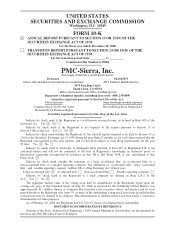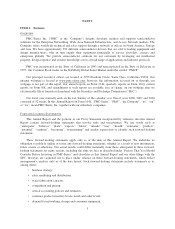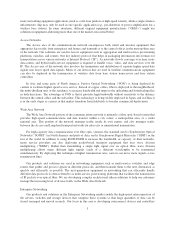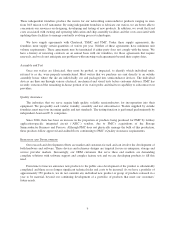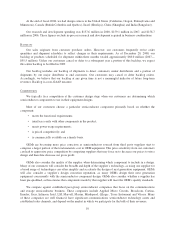Adaptec 2008 Annual Report Download - page 9
Download and view the complete annual report
Please find page 9 of the 2008 Adaptec annual report below. You can navigate through the pages in the report by either clicking on the pages listed below, or by using the keyword search tool below to find specific information within the annual report.
These independent foundries produce the wafers for our networking semiconductor products ranging in sizes
from 0.18 micron to 65 nanometer. By using independent foundries to fabricate our wafers, we are better able to
concentrate our resources on designing, developing and testing of new products. In addition, we avoid the fixed
costs associated with owning and operating fabrication and chip assembly facilities and the costs associated with
updating these facilities to manage constantly evolving process technologies.
We have supply agreements with Chartered, TSMC and UMC. Under these supply agreements, the
foundries must supply certain quantities of wafers per year. Neither of these agreements have minimum unit
volume requirements. These agreements may be terminated if either party does not comply with the terms. We
have a history of renewing contracts on an annual basis with our foundries, for those agreements that require
renewals, and we do not anticipate any problems with renewing such agreements beyond their expiry dates.
Assembly and Test
Once our wafers are fabricated, they must be probed, or inspected, to identify which individual units,
referred to as die, were properly manufactured. Most wafers that we purchase are sent directly to an outside
assembly house where the die are individually cut and packaged into semiconductor devices. The individual
devices are then run through various electrical, mechanical and visual tests before customer delivery. PMC has
recently outsourced the remaining in-house portion of its wafer probe and final test capability to subcontract test
providers.
Quality Assurance
The industries that we serve require high quality, reliable semiconductors for incorporation into their
equipment. We pre-qualify each vendor, foundry, assembly and test subcontractor. Wafers supplied by outside
foundries must meet our incoming quality and test standards. The testing function is performed predominantly by
independent Asian and U.S. companies.
Since 2006, there has been an increase in the proportion of products being produced for PMC by turnkey
application-specific integrated circuit (“ASIC”) vendors, due to PMC’s acquisitions of the Storage
Semiconductor Business and Passave. Although PMC does not physically manage the bulk of this production,
these products follow approved and audited flows conforming to PMC’s Quality Assurance requirements.
R
ESEARCH AND
D
EVELOPMENT
Our research and development efforts are market and customer-focused and can involve the development of
both hardware and software. These devices and reference designs are targeted for use in enterprise, storage and
service provider markets. Increasingly, our OEM customers that serve these end markets are demanding
complete solutions with software support and complex feature sets and we are developing products to fill this
need.
From time to time we announce new products to the public once development of the product is substantially
completed, and there are no longer significant technical risks and costs to be incurred. As we have a portfolio of
approximately 350 products, we do not consider any individual new product or group of products released in a
year to be material, beyond our continuing development of a portfolio of products that meet our customers’
future needs.
9

